Flavorful Flemish Favorites
Over the years, I have visited a lot of cities, but Bruges and Ghent were probably my favorite from a culinary perspective. I know, I know--Belgium doesn't exactly rank high on the list of international food destinations, but that's only because the list is wrong. With their proximity to the North Sea, both Brugge and Ghent have an abundance of fresh seafood, and let's not forget about the famous Belgian chocolates and waffles. So, following in my maternal grandfather's footsteps, I set out to discover my favorite Flemish flavors.
A brief note on the food names in the headers: Because Belgium is bilingual, the first name is in French and the second name is in Dutch. But, because I was in Flanders, I subsequently refer to the foods by their Dutch names.
Frieten/Frites
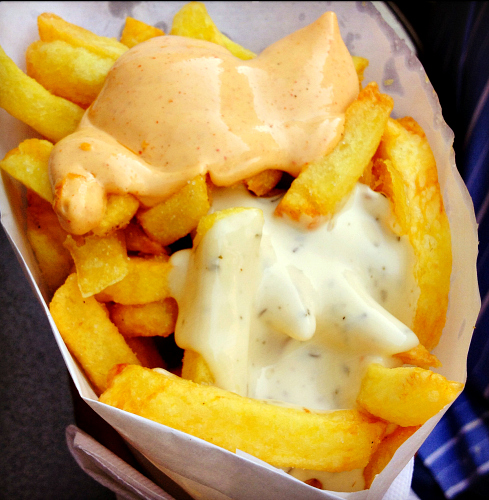
Fries, or chips, if you're British, are popularly believed to have been a French invention, but the Belgians heartily refute that claim. Based on the evidence, I am inclined to agree. The earliest mention of frieten is in 1781, in a book called Curiosités de la table dans les Pays-Bas-Belgiques (Curiosities of the Table in the Belgian Low Countries), which explains that the residents of Belgian provinces had been eating fried potatoes since 1680. So where did the French origin story originate? In America, of course. Apparently, when American soldiers were fighting overseas during World War I, they mistakenly believed that they were served fries in France, not Belgium.
History lesson aside, the Belgians take their frieten quite seriously. There are entire shops or stands, called friteries (French) or frietkot/frituur (Dutch), that are devoted to the sale of them, and they're served with a tantalizing variety of sauces, most of which are mayonnaise-based. If you're like me and kinda sorta hate mayo, you may initially balk at the sauces. Honestly, though, they are often so heavily spiced and augmented with other ingredients (e.g., hot sauce, cayenne pepper, tumeric, cumin, garlic, etc) that you don't even taste the mayonnaise. It was my late morning ritual in Bruges to stroll around the city and munch on frieten, while waiting for my nephew to wake up.
Mosselen-friet/Moules-frites

Considered to be Belgium's national dish, mussels and fries is exactly what it sounds like. Mussels from the North Sea are stewed in a flavorful broth of white wine, shallots, parsley, garlic, leeks, or celery and are served in-shell alongside fries. If you're a fan of mussels, then this is the dish for you. My nephew loved it; I, on the other hand, don't like the texture of mussels, so I only sampled some of his. But the broth was excellent.
Carbonade flamande/Stoverij
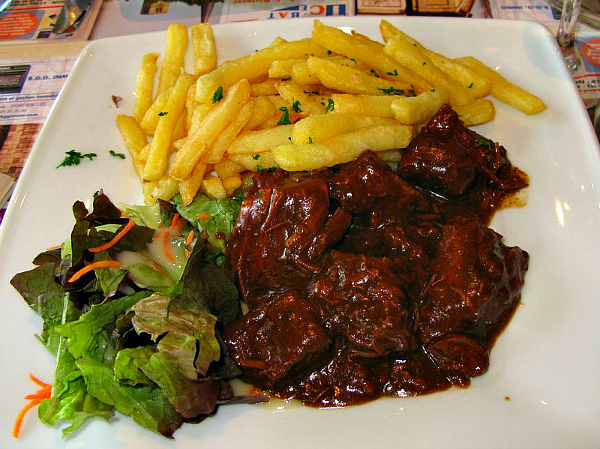
Every European country has its own variant of meat stew, and stoverij is Flemish Belgium's take on it. Traditionally made with beef, onions, thyme, and bay leaves, the ingredient that makes it bonafide Belgian is the Belgian beer it's stewed in. That beer is usually an Oud Bruin (Old Brown) beer, also called Flanders Brown, which is aged for a year to give it a malty, almost sweet flavor and to take away that hoppy bitterness. Naturally, stoverij is served alongside fries. I had this dish on my second day in Bruges, but with pork, instead of with beef. It was absolutely delicious. In fact, I've a hankering for it right now...
Lapin à la gueuze/Konijn in gueze
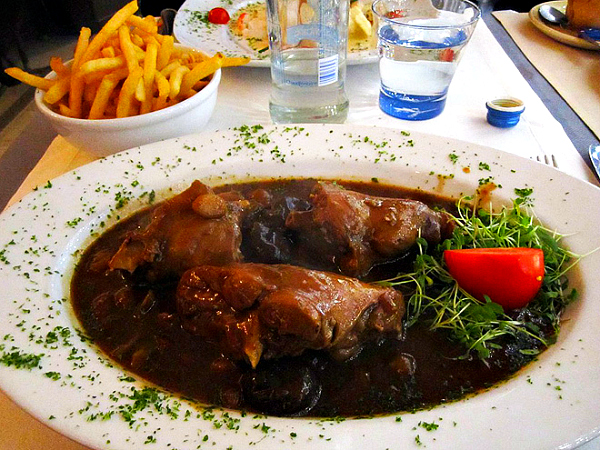
Finicky eaters, bear with me on this next dish; it's really not as gross or scary as it sounds. Because beef and pork stewed in beer were such culinary successes, I guess the Belgians figured that rabbit would be good cooked in it, too. And they were right. I'd had rabbit before and was ambivalent towards it. It's a very lean meat, so it doesn't have a whole lot of flavor, but the Belgians remedied that by pairing it with their twice-fermented lambic beer, called gueze. The beer itself is light and acidic, almost like white wine, so it tenderizes the rabbit and imparts upon it a flavor that is reminiscent of coq au vin, if the vin were white wine, instead of red. So, if you're on the fence about rabbit, try it the Belgian way. I promise you won't hate it.
Waterzooi

Waterzooi has no French translation, because it is strictly a Flemish concoction from the city of Ghent. The original dish consisted of freshwater or saltwater fish boiled (-zooi) in a vegetable broth that was thickened with egg yolk and cream and was further enhanced with potatoes, carrots, onions, leeks, and herbs, such as parsley, sage, bay leaves, and thyme (anyone catch the Simon and Garfunkel allusion?). In modern Flanders, however, chicken stew (kippenwaterzooi) is more common than the historical fish stew, maybe because the rivers surrounding Ghent became too polluted to support fish, so they switched to chicken. Whatever the reason, waterzooi was apparently a favorite food of Charles V, Holy Roman Emperor, who, as you may recall from my previous article, hailed from Ghent.
Zeetong
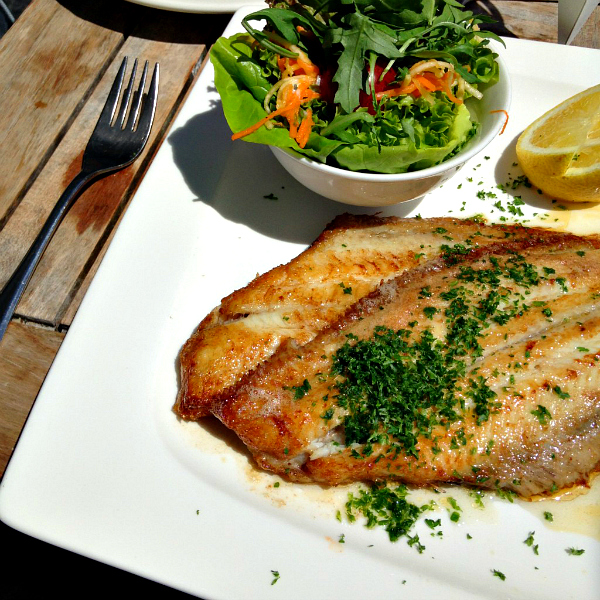
Continuing with the seafood theme is sole, as in the fish. It's a common food in Western and Northern Europe, and I even had it in Rome, Italy, but I fell in love with it in Bruges. Some may laugh at my ode to sole, but it's my favorite fish ever. It's mild, almost buttery, slightly sweet, and definitely not fishy. Cooked simply in butter, the sole I had in Flanders was the best thing I'd eaten on my entire trip. And that's saying something, because everything I ate on that trip was delicious. So, if you find yourself in Bruges with a craving for fish, go to a little restaurant called Poules-Moules (Chickens-Mussels) and order their sole baked in butter, with fries. You won't regret it.
Gaufres (à la Flamande)/Wafel
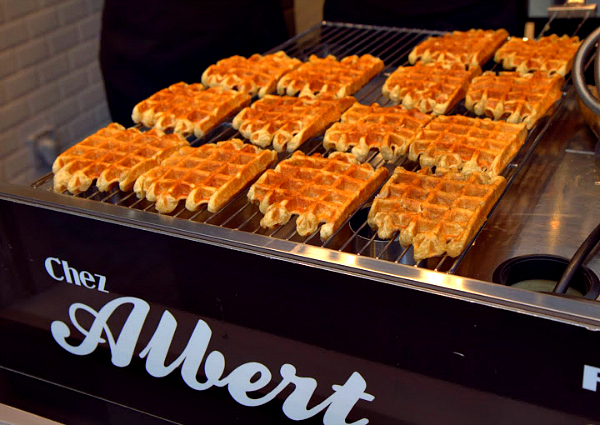
What would an article on Flemish food be without the famous Belgian waffle? There are many different varieties of Belgian waffles, but my favorites are the very similar Brussels and Flemish waffles. Light, airy, and barely sweet, these waffles are served warm on every street corner, topped with ice cream, whipped cream, powdered sugar, fruit, chocolate sauce, or fruit sauces. Unlike in America, waffles in Belgium are considered a dessert, which is as it should be.
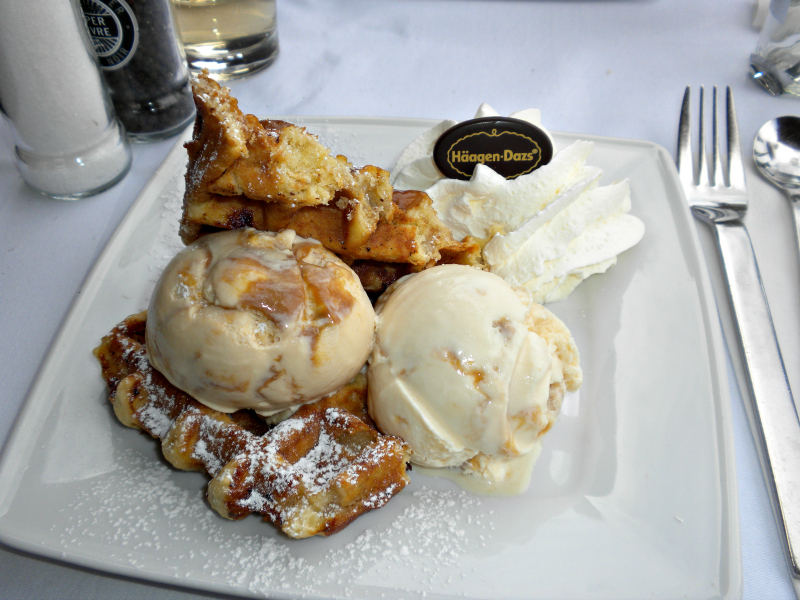
While in Bruges, I naturally indulged in Belgian waffles...every day. I had them topped with Häagen-Dazs ice cream (coffee and caramel flavors), chocolate sauce, and a warm strawberry sauce that, honestly and surprisingly, was my favorite of the three.
Chocolat/Chocolade
Ah yes. Most people have probably tasted Belgian chocolate, thanks to Godiva, but it must be said that the Belgians make the best damn chocolate in the world. Some may argue that the Swiss do, but Swiss chocolate pales in comparison. In fact, I'd go so far as to say that the only chocolate worth eating is Belgian, but I've been accused of being a European food snob, so... (Although, recently I had Hungarian dark chocolate that was on par with Belgian chocolate.)

Bruges was rife with small, independent chocolate shops, and my nephew and I explored them all. No, we really did. We sampled hand-made chocolates from every chocolate shop we encountered; thus, by the end of our sojourn in Bruges, we had our favorites. The Chocolate Line topped my list, partly because of their eccentric flavors (e.g., Coca Cola, wasabi, Cabernet Sauvignon, saké, vodka, etc) and partly because the chocolate was superb quality. Milk chocolate runs the risk of being too milky (Lindt, I'm looking at you) or devoid of chocolate flavor (Hershey...), but The Chocolate Line nailed their milk chocolate. I may have also been swayed by their skull-shaped chocolates.
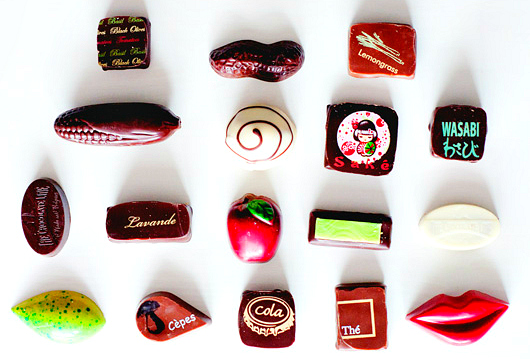
My nephew's favorite shop was Dumon Chocolatier, which, I admit, had the best rose chocolates I've ever tasted. If you want a truly gourmet and luxurious chocolate experience (wow, that sounds pretentious), Dumon is the place to go. They also give you free samples of their chocolate, so, yeah, another point for them.
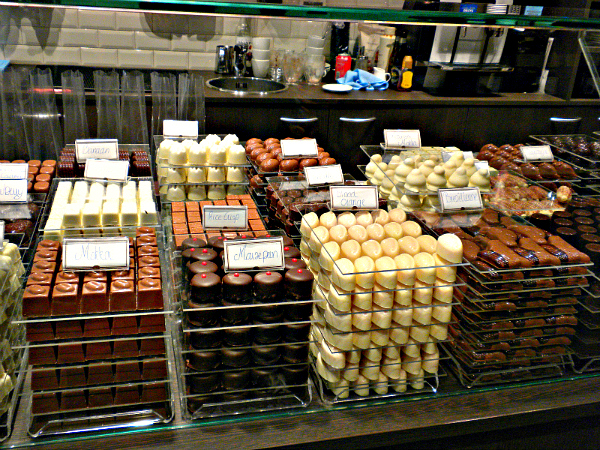
The final chocolate shop I want to mention is Olivier's, because I discovered my love for Earl Grey tea chocolates there. Olivier's is special for another reason: its owner, Olivier, who opened the shop three years ago, when he was twenty-three years old. My nephew laughed at me because I insisted on visiting the shop every day. What? You can't blame a girl for enjoying a little eye candy with her actual candy.
Sources:
1. https://en.wikipedia.org/wiki/Belgian_cuisine






